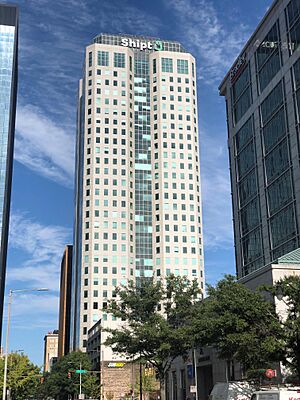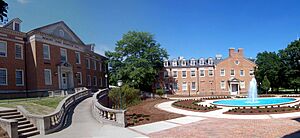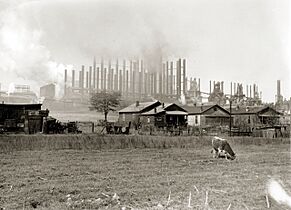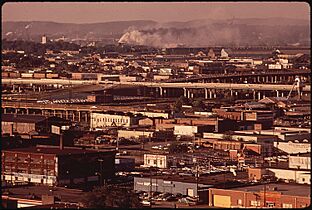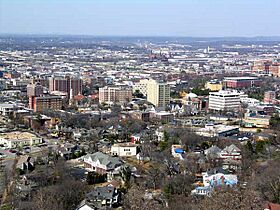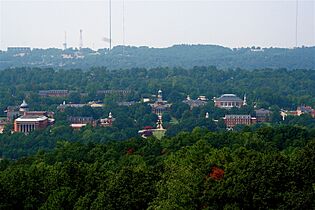Timeline of Birmingham, Alabama facts for kids
Welcome to the exciting history of Birmingham, a major city in Alabama, USA! This timeline will take you on a journey through the years, showing how Birmingham grew from a new town into the bustling place it is today. You'll discover important moments, famous buildings, and how the city changed over time.
How Birmingham Began: The 1800s
- 1871: Birmingham was officially started and became a city.
- Robert Henley became the first mayor.
- 1874: Birmingham became the main city for Jefferson County.
- The First Colored Baptist Church was founded.
- A serious illness spread through the city.
- The Birmingham Iron Age newspaper started publishing.
- 1880: The city's population was 3,086 people.
- 1881: The Alabama Christian Advocate newspaper began publishing.
- 1882:
- The Sloss Furnace, a big iron factory, started working.
- O'Brien's Opera House opened, a place for shows and performances.
- 1887: Howard College began operating in East Lake.
- 1888: The Evening News and Birmingham Age-Herald newspapers started publishing.
- 1890:
- The population grew to 26,178 people.
- The Labor Advocate newspaper began publishing.
- 1891: The Birmingham Commercial Club was officially formed to help businesses.
- 1893:
- The beautiful Cathedral of Saint Paul was built.
- St. Mark's School opened.
- 1895:
- The Tennessee Coal, Iron and Railroad Company, a large industrial company, moved its main office to Birmingham.
- The Birmingham Conservatory of Music was started.
- 1896: Spencer Business College was established.
- 1900: The population reached 38,415 people.
Birmingham in the 1900s
Early 1900s: Growth and Change
- 1901: March 25: A big storm hit the city.
- 1907:
- The Tennessee Coal, Iron and Railroad Company was bought by the United States Steel Corporation, a huge steel company.
- Miles Memorial College was active in nearby Fairfield.
- 1909:
- Birmingham grew bigger, adding areas like Ensley, North Birmingham, Pratt City, and Woodlawn.
- The Birmingham Terminal Station (a train station) and the Empire Building were built.
- 1910: The population jumped to 132,685 people.
- 1912: The John Hand Building was built.
- 1913: The City Federal Building was constructed.
- 1916:
- October 18: An earthquake shook the area near Irondale.
- A local group of the Klan was formed.
- 1917: The Civitan Club, a community service group, was founded.
- 1918: Birmingham–Southern College was established.
- 1919: The Alabama Federation of Business and Professional Women's Clubs was formed in Birmingham.
- 1920:
- The Progressive Farmer magazine moved its main office to Birmingham.
- The population reached 178,806 people.
- 1922: WAPI radio began broadcasting.
- 1923: Traffic lights were installed to help manage cars.
- 1924: The Avondale Sun newspaper began publishing.
- 1925: WBRC radio began broadcasting.
- 1927: The Alabama Theatre opened, a beautiful place for movies and shows.
- 1928: Exchange-Security Bank was established.
- 1929: The Thomas Jefferson Hotel was built.
- 1930:
- The Southern Worker newspaper began publishing.
- The population grew to 259,678 people.
- 1933: The Mine, Mill and Smelter Workers Union was active, helping workers.
- 1936:
- A local Steel Workers Organizing Committee was formed.
- The Vulcan statue, a huge iron statue, was put on top of Red Mountain.
- 1940: The population was 267,583 people.
- 1942: The Birmingham Historical Society was founded to preserve history.
- 1949: WAPI-TV and WBRC-TV (television) began broadcasting.
- 1950:
- The Birmingham Post-Herald newspaper started publishing.
- The population reached 326,037 people.
- 1955: The Birmingham Zoo was established, a fun place for animals.
- 1956:
- The Alabama Christian Movement for Human Rights, an important group for civil rights, had its main office in Birmingham.
- The Alabama Symphony Orchestra became active.
- 1958: EBSCO Industries, a large company, started its business.
- 1959: The West End Hills Missionary Baptist Church was built.
Later 1900s: Civil Rights and Modernization
- 1960:
- Briarwood Presbyterian Church was established.
- Eastwood Mall opened for shopping.
- The population was 340,887 people.
- 1961: First Baptist Church, Kingston was built.
- 1962: The Two North Twentieth building was constructed.
- 1963:
- April 3: The Birmingham campaign for civil rights began, a very important time for equal rights.
- April 16: Martin Luther King Jr. wrote his famous "Letter from Birmingham Jail".
- May: There were protests and events related to civil rights.
- September 15: The 16th Street Baptist Church bombing occurred, a tragic event.
- The Birmingham Botanical Gardens opened, a beautiful place with plants.
- 1965:
- Airport Drive-In cinema opened.
- The Southern Museum of Flight was established.
- 1966: Southern Living magazine moved its main office to Birmingham.
- 1969: The old Birmingham Terminal Station was taken down.
- 1970:
- The Daniel Building was constructed.
- The population was 300,910 people.
- 1971: First Alabama Bancshares moved its main office to the city.
- 1972: The South Central Bell Building and First National-Southern Natural Building were built.
- 1975: The Birmingham Vulcans football team was formed.
- 1979: Richard Arrington, Jr. became mayor.
- 1980: The population was 284,413 people.
- 1982:
- The Community Food Bank of Central Alabama and Bama 6 cinema opened.
- Birmingham became a sister city with Hitachi, Japan, creating a special friendship.
- 1986:
-
- The South Trust Tower was built.
- The Alabama Humanities Foundation moved its main office to Birmingham.
- 1988: The AmSouth-Harbert Plaza (a tall building) was built.
- 1990:
- The Birmingham Islamic Society was formed.
- The population was 265,968 people.
- 1992: The Birmingham Civil Rights Institute was established, a museum about the civil rights movement.
- 1993:
- The Alabama Jazz Hall of Fame opened.
- Spencer Bachus became a U.S. representative for Alabama's 6th congressional district.
- 1995: Birmingham became a sister city with Székesfehérvár, Hungary.
- 1996:
- The city's website went online around this time.
- Birmingham became a sister city with Anshan, China.
- 1997: Birmingham became a sister city with Gweru, Zimbabwe.
- 1998:
- There was a big tornado outbreak from April 6-9.
- Birmingham became sister cities with Pomigliano d'Arco, Naples, Italy, and friendship cities with Chaoyang District, Beijing, China, and Maebashi, Japan.
- 1999: Birmingham became a friendship city with Krasnodon, Ukraine.
- 2000: The population was 242,840 people.
Birmingham in the 2000s and Beyond
- 2001: Church of the Highlands was founded.
- 2003: Birmingham became a sister city with Vinnytsia, Ukraine.
- 2005:
- The Birmingham Post-Herald newspaper stopped publishing.
- The Locust Fork News-Journal began publishing.
- Birmingham became sister cities with Al-Karak, Jordan; Guédiawaye, Senegal; Plzeň, Czech Republic; and Rosh HaAyin, Israel.
- 2009: Birmingham became a sister city with Winneba, Ghana.
- 2010:
- The Alabama Symphony Youth Orchestra was formed.
- William A. Bell became mayor.
- The population was 212,237 people.
- 2011: Terri Sewell became a U.S. representative for Alabama's 7th congressional district.
- 2015:
- A new minimum wage was approved in the city.
- Birmingham became a sister city with Liverpool, England.
- 2017: Randall Woodfin became mayor.
- 2020: The population was 200,733 people.
- 2021: The Birmingham Stallions football team was formed.
- 2022: The 2022 World Games, a big international sports event, were hosted in Birmingham.
- 2024: September: A tragic shooting occurred in Birmingham.
Images for kids

All content from Kiddle encyclopedia articles (including the article images and facts) can be freely used under Attribution-ShareAlike license, unless stated otherwise. Cite this article:
Timeline of Birmingham, Alabama Facts for Kids. Kiddle Encyclopedia.

